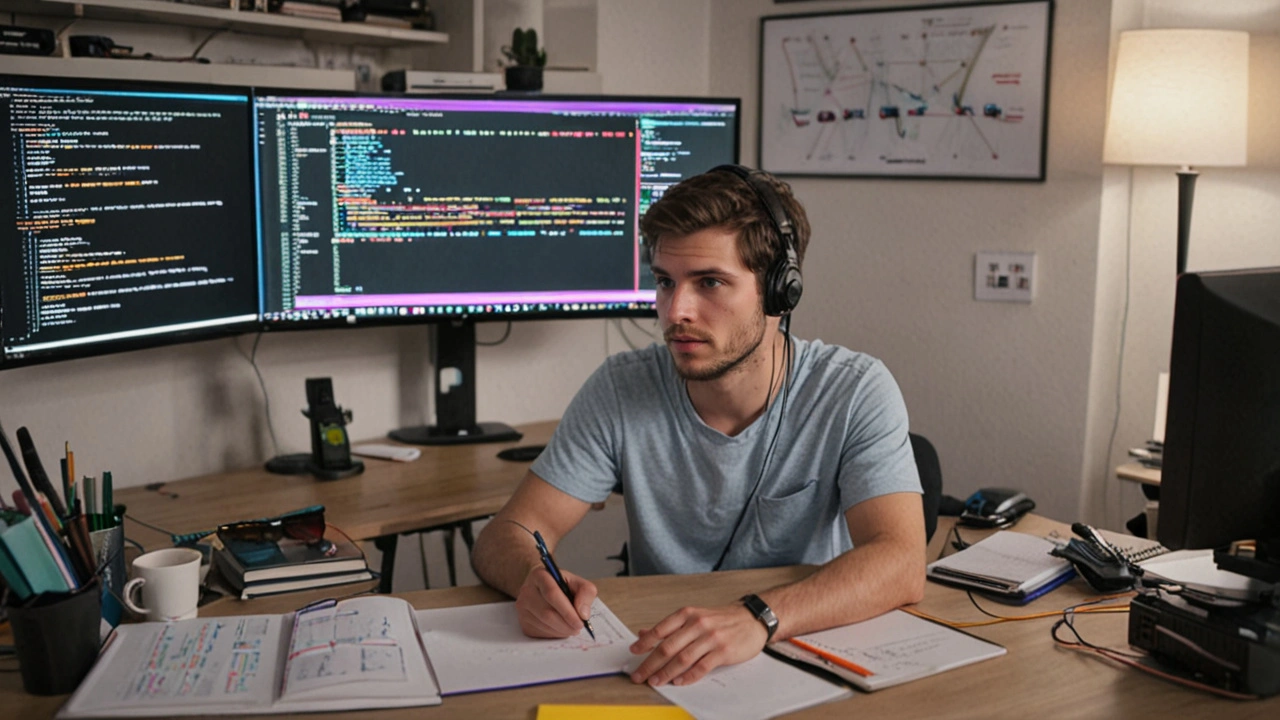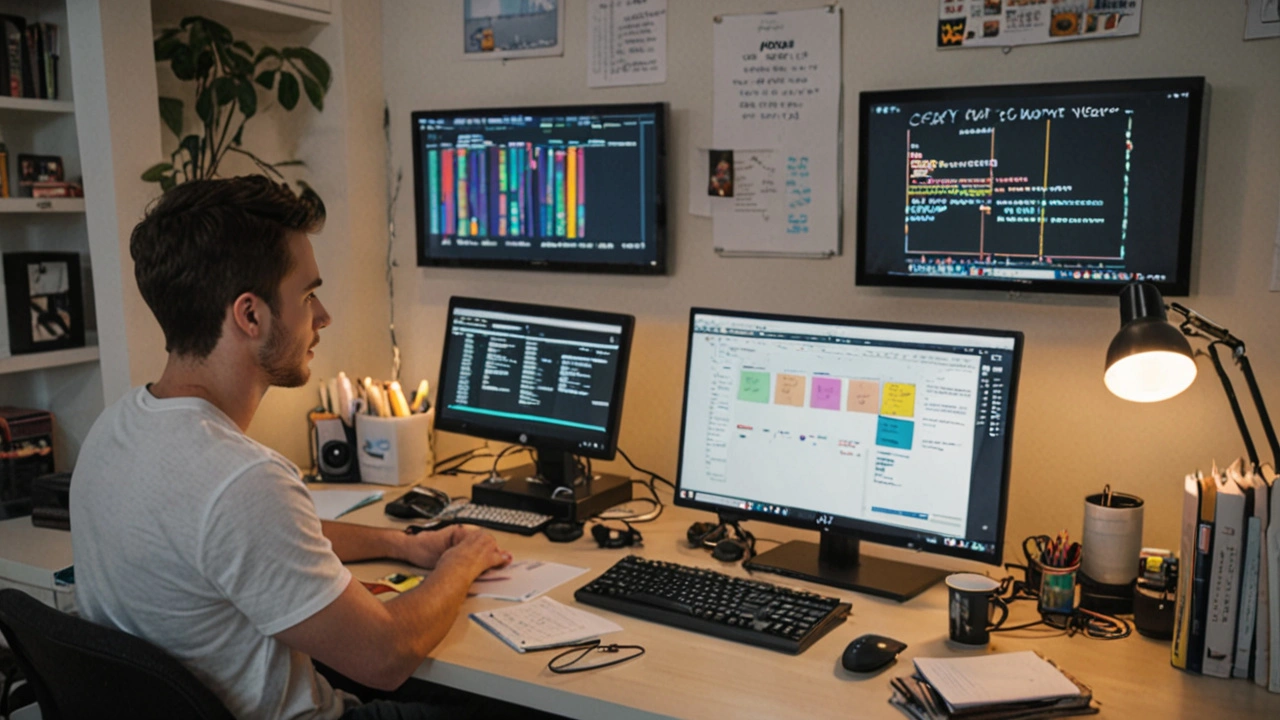Diving into the world of programming can feel like a daunting task, but with the right guidance, anyone can start their tech journey on the right foot. If you're new to coding, this tutorial is designed to help you navigate the basics and get you started.
We'll begin by understanding what programming is and why it’s a valuable skill today. Then, we'll help you select a programming language that suits your needs and interests. You'll also learn how to set up your computer for coding, write your first lines of code, and discover resources that will support your learning path.
With clear steps and practical advice, you're about to unlock a new world of possibilities. Ready to get started? Let's dive in.
- Introduction to Programming
- Choosing a Programming Language
- Setting Up Your Environment
- Writing Your First Code
- Resources for Continued Learning
Introduction to Programming
Programming, in its simplest form, is the craft of writing instructions that computers can understand and execute. These instructions tell the computer what tasks to perform, step by step. Those who engage in this are known as programmers or developers. Whether it’s a simple app on your phone or a complex software system used by businesses, programming lies at the heart of modern technology.
Learning to program can open up a world of opportunities. According to a report from the Bureau of Labor Statistics, employment in computer and information technology occupations is projected to grow 13 percent from 2020 to 2030, much faster than the average for all occupations. This demand is driven by the need for new applications for smartphones and tablets, as well as the need to safeguard digital data and maintain network systems.
At its core, programming involves understanding a problem and then designing a logical sequence of steps to solve it. It’s akin to solving a puzzle or following a recipe. Each programming language has its syntax and rules, akin to the grammar and vocabulary of a human language. Some of the popular programming languages today include Python, JavaScript, and C++.
“Everybody in this country should learn to program a computer, because it teaches you how to think.” – Steve Jobs
Many people find programming intimidating at first glance. However, it's important to remember that every skilled coder started as a beginner. The key is to start small and gradually build up your skills. With patience and practice, you'll soon find yourself more comfortable with coding.
Programming also teaches valuable skills beyond technical knowledge. Logical thinking, problem-solving, and creativity are just a few of the benefits. As you progress, you’ll learn to break down complex problems into smaller, manageable pieces. This skill is not only useful in coding but in any analytical or strategic task. It's an essential mindset in today's digital world.
The field of programming is vast, and there's always something new to learn. From web development and data analysis to artificial intelligence and game design, the possibilities are endless. Whether you want to develop a website, create an app, or automate tasks, programming gives you the power to bring your ideas to life.
Starting your programming journey requires dedication and the willingness to experiment and make mistakes. It's a field where continuous learning is part of the job. Many resources are available to help beginners, from online courses and tutorials to coding bootcamps and community meetups. The programming community is known for its openness and willingness to help newcomers, so don't hesitate to seek advice and support.
Choosing a Programming Language
Diving into programming begins with an important decision: picking the right language to start with. The choice can seem overwhelming with so many options available, but breaking it down to your goals and interests makes it easier. A popular entry point is Python, known for its simplicity and versatility. Its easy-to-read syntax mimics human language, making it ideal for beginners. Python is widely used in web development, data science, and automation.
If web development grabs your attention, consider starting with JavaScript. As the cornerstone for many websites, JavaScript powers dynamic content across the internet. It's essential for front-end development and increasingly crucial on the server-side with environments like Node.js. JavaScript doesn't require complex setup, allowing you to start coding directly in your browser, which is perfect for beginners looking to see immediate results.
For those interested in mobile app development, Swift and Kotlin are effective choices. Swift, developed by Apple, is the primary language for iOS apps, while Kotlin is endorsed by Google for Android development. Both languages offer modern syntax and tools that streamline the creation of mobile apps, giving you a solid footing in this booming field.
Understanding the efficiency and reliability of the field might lead you to Java. Used by large enterprises around the world, Java is a mainstay in backend development, Android apps, and complex systems. Its robust ecosystem and strong community support ensure extensive learning resources and job opportunities. Similarly, C++ is another powerful language, particularly for systems programming, game development, and applications requiring high-performance execution.
Another language to consider is Ruby, known for its elegant and readable code. Ruby on Rails, a popular framework, simplifies web application development and promotes best practices. Ruby’s focus on simplicity and productivity makes it an attractive option for beginners looking to build web applications.
For those curious about programming for embedded systems or getting close to the hardware, C remains a timeless choice. Though older, it's regarded as a foundation for understanding how computers work. Proficiency in C opens doors to understanding more complex languages later on and is widely respected in the tech community.
As you consider your options, reflect on your long-term goals. Each language has its strengths and specific areas of application, so think about the kinds of projects you want to work on. Start with one language and become familiar with its concepts before branching out to others. Speaking of branching out, many seasoned programmers advocate learning multiple languages—each new language brings a different perspective and enhances your problem-solving skills.
“The more languages you learn, the easier it becomes to learn a new one,” says industry expert Martin Fowler.
To help visualize these languages and their common uses, here's a simple comparison:
| Language | Primary Use |
|---|---|
| Python | Web Development, Data Science |
| JavaScript | Web Development, Server-side |
| Swift | iOS App Development |
| Kotlin | Android App Development |
| Java | Backend Development, Android |
| Ruby | Web Development |
| C | System Programming |
Choosing the right programming language is the first step in an exciting journey. Take your time, explore your interests, and don't be afraid to dive in. The world of coding is vast and full of opportunities waiting to be discovered.

Setting Up Your Environment
Setting up your coding environment is like preparing the ground before planting seeds. It's the first and crucial step to a smooth and enjoyable programming journey. The key is to ensure that your tools and setup are ready so you can focus on learning and creating. This section will guide you through this setup process in an easy-to-follow manner.
First, you'll need a good computer. While many programming languages can run on simple machines, investing in something more powerful can save you time and frustration later. A reliable laptop or desktop with at least 8GB of RAM will suffice for most beginners. If you can stretch your budget, consider 16GB of RAM, as it will keep things running smoothly even with multiple applications open.
Next, you'll need to choose an Integrated Development Environment, or IDE. Think of an IDE as your digital workshop where you can write, test, and debug code. For beginners, Visual Studio Code is a top recommendation. It's free, customizable, and supports many programming languages through various extensions. Another fantastic choice is PyCharm if you're leaning towards Python. For web development with HTML, CSS, and JavaScript, Sublime Text or Atom are great picks.
"An investment in knowledge pays the best interest." – Benjamin Franklin
After selecting an IDE, it's time to install it. Head over to the official website of your chosen IDE, download the proper version for your operating system, and follow the installation instructions. During installation, you may be prompted to configure some settings. While the default settings often work well for beginners, tweaking them for personal comfort can enhance your experience.
Version control is another fundamental part of a programmer's environment. It allows you to manage changes in your project, preventing data loss and making collaboration easier. Git is the most popular version control system. To start, download Git from its official website and install it. Once installed, you'll need to create a GitHub account. GitHub is a platform where you can host your Git repositories, share your code, and collaborate with others.
Unlike the initial hardware setup, this stage often involves setting up multiple tools. It might seem a bit overwhelming, but it's worth the effort. A standard setup might look like this:
- A reliable computer with at least 8GB RAM
- Visual Studio Code or your preferred IDE properly installed
- Git for version control
- A GitHub account for hosting your projects
Finally, there's configuring your environment to code in the specific language you have chosen to learn. If you decide to start with Python, you’ll need to install Python from the official website. Make sure to add Python to your system path during installation. For JavaScript, installing Node.js is essential, as it allows you to run JavaScript outside the browser. Each programming language has its setup steps, so check the official documentation for the best practices.
Configuring your environment may seem like a laborious task, but once set up, it makes your coding experience much smoother. Keep your tools updated, your workspace organized, and you'll be ready to dive into the fun part—writing your first lines of code. Now that your environment is ready, you're all set to embark on your programming adventure.
Writing Your First Code
By now, you're probably eager to start coding and see your creation come to life. Writing your first piece of code is a significant milestone and can be both exciting and nerve-wracking. Let's break it down into simple, manageable steps.
First things first, you need a text editor or an Integrated Development Environment (IDE). Text editors like Notepad++ or Sublime Text are good starting points, but IDEs like Visual Studio Code offer additional functionalities that make coding more comfortable. They're equipped with features like syntax highlighting, code suggestion, and debugging tools.
For our first coding adventure, we'll use Python due to its simplicity and readability. Open your text editor or IDE and start a new file. Let's create a program that prints

Resources for Continued Learning
Once you’ve dipped your toes into programming, you'll find that there is always more to learn. The tech world is ever-evolving, and staying updated with the latest trends and skills is essential. Here are some incredible resources to help you continue your learning journey and deepen your programming knowledge.
The first go-to for many learners is online learning platforms. Websites like Coursera, edX, and Udacity offer courses from reputed universities and organizations. These courses range from beginner to advanced levels, often include hands-on projects, and provide certificates upon completion. Codecademy and freeCodeCamp are also great for interactive coding practice.
“Education is not the filling of a pail, but the lighting of a fire.” — William Butler YeatsBooks are timeless resources for deepening your knowledge. Whether it's

